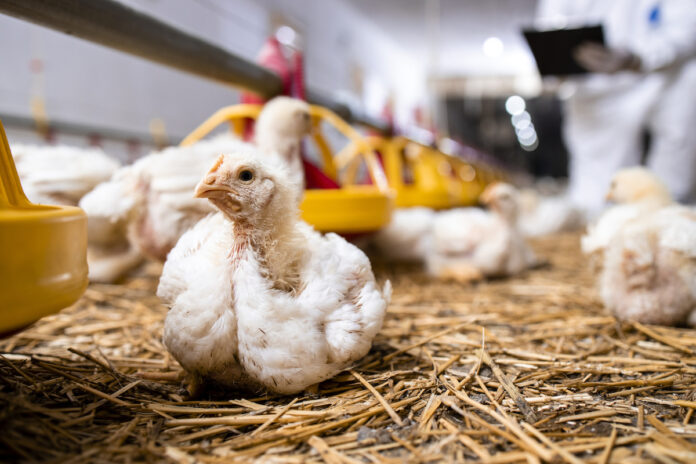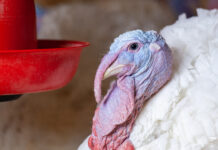
Farming broilers today has some very real challenges, namely birds are reaching their kill weights quicker, the profits from farming chicken are under pressure, technology is developing faster than the industry can keep up with, recruiting and retaining good farm managers is very difficult and the industry needs to use less medication whilst maintaining bird welfare and productivity.
A new way of farming that is more focused on precision and technology maybe the answer but this will require a fresh way of thinking and an adjustment in the way business invest and operate. There is a possibility to invest in technology, commit time and resources to using data outputs from technology as a business tool and starting to have ways of reliably forecasting what the birds require. The potential of this new approach is that we will be aware of things well before the birds show any actual physical symptoms. This approach will allow for not only improved productivity but clearly also further improved bird welfare.
Introduction
Globally chicken meat is fast becoming one of the, if not the, most eaten meat proteins. Consumers globally like the versatility and consistency of the product. However consumers also like the cost of the product meaning that it is difficult to add value beyond smaller niche sectors within the industry. This means that whilst demand for the product is rising and production volumes are rising, the economic returns for the farmer are becoming in real terms less each year. For farming businesses to survive going forward they need to ensure that they are getting the absolute best performance from their birds and at the same time meeting the demands of the consumer.
Modern broiler production requires the traditional stockmanship skills of the past but this may not be enough on its own. Bird performance and bird welfare require attention 24 hours a day, 7 days a week and as technology evolves there is a real possibility of enhancing our current practices by predicting what is going to happen over the coming days, not just watching and seeing what happens followed by a reaction to the symptoms. The industry has a real opportunity to become proactive and not only reactive.
Never has this been more important than today when all meat protein production is under real pressure to reduce the usage of antibiotics in the production systems. At present antibiotics offer one of the few options for reactive intervention when detrimental symptoms are seen in our birds. Sensible and appropriate antibiotic usage is generally considered good for animal welfare and good for the farming business however, with rising pressures to get usage to an absolute minimum we must learn more about our birds and learn it quicker to allow us to utilise other alternatives such as probiotics for animal gut health.
Design of a facility
When considering a fresh approach to farming broiler chickens many things start with the design of the chicken farm and its environment for the birds. Important aspects to consider include biosecurity measures. Biosecurity is clearly understood by all to be the first defence in protecting in-door reared poultry from disease challenges. The best biosecurity designs ensure that staff fulfil the requirements every time they enter a premises, no matter for what they are entering or for how long they plan to be in there. This requires staff training in awareness but also for the facility to be designed to make the use of biosecurity measures as simple and straight forward as possible.
Bird behaviour
In evaluating design features of our broiler units it is also essential that we consider the birds themselves and understand what they truly desire from their environment. Recent advances in technology have allowed us as farmers to better understand the specific needs of the birds. For example evidence on farm has shown that birds will consume more feed and water to the outer edges of a broiler house than in the middle area. Why then do we evenly space feed and water access across a house if more want access to the outer areas? Other behavioural data has also shown a natural digression of bird activity through the 24 hour day and so we need to design facilities for all levels of activity, those higher levels in the early morning as well as the less active evenings.
It is essential for the birds to perform commercially to their optimal at all times and as new technologies are developed, the birds themselves are to be considered. Recent on farm trials using new technologies and data analysis are helping to ensure that newly introduced technologies such as LED lighting are not compromising bird welfare or performance.
Ventilation
A key element of any broiler farm is its ventilation. In simple terms we want to introduce oxygen for the birds to utilise through respiration whilst removing carbon dioxide, water vapour and other non beneficial gases such as ammonia. We want to fulfil this process during all weathers and at all times of day, whilst maintaining a static environment for the birds themselves. This is difficult to achieve when the physical properties of air are considered. Cooler air acts differently to warm air and the birds feel the effects of the air by way of a mixture of physical factors; the temperature of the air, the moisture content of the air and the speed at which the air is travelling.
Modern broiler facilities have an array of sensors and technology to monitor and manage these factors and give consideration to the effects of the specific air properties have on the birds at that actual moment, but it is possible to use various technologies and equipment to assess the environment manually in all facilities whatever their age, design or state of repair. Often the biggest causes of problems are simple to fix and may simply require staff training in ventilation or some simple maintenance to be completed.
Water
Water consumption is a key area in broiler production requiring analysis and understanding. Monitoring consumption flow rates as well as daily consumption figures can give great insight into the birds, their growth and welfare. We are able to consider everything, from activity and potential growth rates through to understanding the intestinal integrity of a bird at any given moment. Companies supplying drinker equipment now offer precise ways to control the birds access to water by controlling the water pressure in the drinker lines. Given that water is consumed at nearly twice the level of feed it is essential to monitor and control its uptake. Drinker heights, cleanliness, physical properties as well as flow rates are all essential pieces of information in managing broilers.
Predictive management
Previously any predictive data was established on a genetic type basis, e.g. a bird of this genetic strain has the potential to grow at a certain rate and will eat and drink predicted amounts to achieve this. All based on trials conducted by the genetic companies. The great thing now is having the ability to predict for each farm specifically, in some cases exceeding genetic averages and in others establishing more achievable targets for their specific scenario.
The future
Broiler farming requires the control and management of a whole range of parameters and as such technological advancements are almost unlimited. As sensors develop the industry will be able to embrace them and use them for its own needs. Some will give more data and information, more accurately and quicker than we can currently, such as electronic noses detecting disease days earlier than symptoms are seen by the eye. Other technologies will be about labour saving and will offer a better solution to the current shortage of good reliable labour to work with the birds, such as robotic technologies.
One significant change maybe the way in which we all purchase and operate these new technologies. Be it due to the prohibitive capital cost of technologies or the complex operational demands of the technologies, we are likely to see a move towards service based technologies. You will not, as a farmer, necessarily own the sensors but instead purchase the information that is gathered by the sensors. You may not own a robot but instead pay someone to remove your dead birds on a hourly basis and they in turn will supply a robot to do that at their cost. We are already seeing these models in the consumer economy with items such as cars and razor blades, effectively offered with monthly subscriptions.
Conclusion
Broiler farming is an agricultural sector that operates on small margins but large volumes and so, the potential to improve bird welfare and farmers margins is considerable if small improvements in efficiency can be made. From what is generally globally an efficient sector, the best way to further drive improvements in productivity and welfare is to focus on the precision of our businesses and one essential prerequisite to precise management has to be the embracing of technologies and the data generated to give us better, more accurate, information for even better and faster decision making on farm.
All of this requires investment and the cost of some of this new information will be paid for either by way of capital purchases of equipment or more likely, the purchase of the information on a subscription basis. Future broiler businesses will need to embrace production partners which is in many ways similar to the integrated production models that already exist in the broiler sector globally only involving many technology and information partners rather than one commercial partner.
From the Proceedings of the 4th International Poultry Meat Congress
















